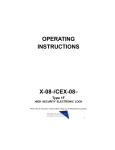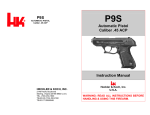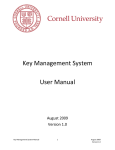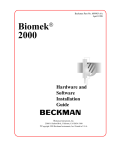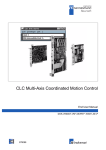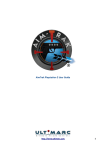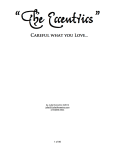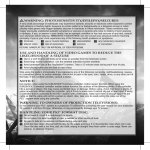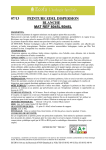Download REVOLVERS - JS Publications
Transcript
REVOLVERS A pair of single action revolvers is required. A single action revolver is one in which the shooter must manually cock the firearm before pulling the trigger. This is different from a double action revolver in which the trigger pull will both cock and fire the gun. The rules also mandate that the firearm be either an original or replica of one that was available in the period up to 1899. This includes: the S&W Model 3, variations and reproductions; the Colt Single Action Army and reproductions (including the Ruger Vaquero and Blackhawk); the Colt Bisley and reproductions (including the Ruger Bisley Vaquero), the Remington 1875 and reproductions; and various cap and ball guns made by Colt, Remington, and others (as well as reproductions). Selecting a revolver is a matter of personal choice and comfort. The shooter should try out as many different varieties as possible before determining the preferred model. Go to several different gun shops and handle as many varieties as you can before buying. Once a model has been selected, caliber and barrel length is the next choice. In general, shorter barrels and smaller calibers handle better than longer barrels and bigger calibers. However, it is possible to load a .45 Colt cartridge so that the recoil is similar to .38 Special, though shot precision can suffer. Less experienced shooters may be better served by one of the smaller caliber revolvers as there is less recoil to absorb. Competitive Note: Look for revolvers that fit your hand well and point at the target naturally. Select one with sights that are comfortable and natural. A square rear sight notch is essential for quick sight acquisition. CONFIDENCE AND FUNDAMENTALS Now that you have selected your revolvers and leather, it’s time to develop complete confidence and basic techniques. The first thing to do is take the revolvers down for a good cleaning. This will help you become familiar with their operation and any quirks they may have. In addition, it will ensure that you start out with clean, well-maintained equipment. If you have questions or problems with disassembly and cleaning, check the user manual that came with the guns or contact the shop where they were purchased. Proper grip, stance, sighting, target acquisition, drawing and holstering all need to be perfected. Grip, stance, sighting, and trigger squeeze are the basic fundamentals every shooter needs to know. Learning target acquisition, and drawing and holstering are the first steps to becoming a competitive shooter. WARNING: When practicing at home, MAKE ABSOLUTELY SURE that there is no live ammunition in the room or in the gun. This is an easy way to make a mistake and have an accidental discharge (AD). Spend the time to go through the area and move any ammunition to another part of your house or apartment. The dry fire drills covered in this section are ones that I use and some of the top shooters in the game use. They are designed to help you become comfortable with your equipment and learn the basic gun handling skills needed to excel. Spend some time on the dry fire drills listed and become familiar with your guns and learn basic sighting, stance, and grip. I can’t over-emphasize the importance of these drills. I return to them at the beginning of every practice session. Dean Perry (Punch) practices his revolver fundamentals using a modified Weaver stance. The live fire drills covered in this section will help you learn to shoot and get you comfortable. Making sure that your guns print on paper to exactly the same spot they are aimed is important in developing confidence in your equipment. If they don’t shoot where you aim, take the guns, some of your ammunition, and targets with you to a gunsmith to have the point of aim (POA) adjusted to the point of impact (POI). Occasionally I will use the term “break the shot.” This refers to the act of squeezing the trigger and waiting for the shot to go off. There is a time lag between when the trigger disengages the sear and when the hammer actually causes the firing pin to set off the shot. While minimal, the delay is real. When you “break a shot,” make sure to follow through the entire shot. Everything follows fundamentals. If your fundamentals are solid, you can perform well. Until your fundamentals are sound, you can’t learn to shoot fast accurately. DRY FIRE PRACTICE Dry fire practice is one of the most effective means of training you can do. While range time is needed to ensure that you haven’t picked up any bad habits, the time you spend on dry fire practice (especially transitions and target acquisition) can really make a big difference in your scores. In order to perform the dry fire drills you will need some small targets (I use small sheets of paper taped to the wall), snap caps, your gun leather, and no distractions. Make sure to wear your shotgun belt or slide as well. You want your practice to be as close to match conditions as possible. There are four fundamentals to revolver shooting: grip, trigger pull, stance, and sights. Once you have found your grip and stance, using the sights comes much more naturally. Grip and Trigger Before we start, make sure there is no ammunition in the area, and your revolvers are not loaded. If your grip isn’t natural, comfortable, or strong, you won’t be able to shoot well consistently. And, you won’t be able to recover from recoil because Jeff Moser (Three Finger Jake) your grip shifted during the recoil of the shot. demostrates proper grip. Your grip must be exactly the same every time you pick up the revolver and for every shot. It must be strong and comfortable without causing fatigue. In addition, the grip must put your trigger finger into the trigger guard for a pull that is straight back into the web between your thumb and forefinger. To find this grip, hold the gun in your weak hand with the barrel pointing forward and the grip toward the rear. Line the web between your thumb and forefinger up to the middle of the grip strap and push your hand straight forward until the web of your hand hits the grip strap. Wrap your finger snugly around the grip so that your forefinger naturally finds the trigger. Depending on your revolver and the size of your hands, there may not be enough room on the grip for all of your fingers. That’s just fine. Put your little finger under the front of the grip. If you shoot with a one-hand hold (duelist style), then this is your grip. You should hold the revolver as if you are giving a firm handshake; you aren’t trying to strangle something. Most of the tension should be in the bottom three fingers on the grip. This leaves the trigger finger relaxed and free to work the trigger. However, you need a tight enough grip that the recoil can be managed. If you shoot with a two-hand hold, grip the gun in your strong hand as described above. With your weak hand, wrap your fingers around the front of your strong hand in such a way as they are lined up in the gaps between the fingers of your strong hand. Bring your palm into the grip, with your thumb free to work the hammer. The forefinger on your weak hand should find a comfortable place on the front of the trigger guard. Billy Abbate (TG Reaper) puts his first two fingers in front of the trigger guard. This puts his hand in position to use his wrist to move his thumb. This uses big muscles, is less fatiguing, and is faster for him than any other method. There are a few different thoughts regarding the weak hand. One is that it is there for support and to help hold the gun steady. The other is that it is there only to provide a platform for the thumb to cock the gun. I subscribe to the latter. Many excellent shooters subscribe to the former. While my left hand does provide some support, I look for a way to place it so that I can best work the hammer with my thumb. If you use the weak hand as part of the support platform for the gun (and this does stabilize it), then you should used the “push-pull” method. This means that your strong hand pushes the gun forward and your weak hand pulls the gun toward you. These pressures are fairly light and help to promote a stable platform. Note: Every time you pick up your revolver, use this grip. You must ingrain the grip into muscle memory by repetition. Repeat the grip over and over until it becomes natural and automatic. Now that you know how to find your grip, load your revolver with SNAP CAPS. Pick up your revolver. You are using the new grip, right? Draw the hammer back (using the thumb of your weak hand with a two-hand hold, or with the thumb of your strong hand using a one-hand hold). With the pad of your forefinger on the trigger, slowly squeeze it straight back into the web of your strong hand. At some point, the sear will disengage and the hammer will fall. It took you by surprise, didn’t it? If it didn’t, try it again only much slower. When you squeeze the trigger, the gun shouldn’t move up or down, or right or left. Do this over and over until it becomes natural and automatic. One last note: Throughout the rest of this section, I will keep mentioning the grip. I can’t stress it enough. The proper grip is vitally important to keep control of your revolver, maintain accuracy, and speed recovery from recoil. Stance There are several different options for stance. In general, the shooter must find the one that works the best. I have a different one for each shooting style, and for different holster configurations. In this case, I’ve broken it down to options for a two-hand hold and for a one-hand hold. Two-Hand Hold Before we start, make sure there is no ammunition in the area, and your revolvers are not loaded. Let’s try this exercise first. Tape a small target up on the wall. Grip your revolver with a two-hand hold. You are using the grip described earlier, right? Now, aim your revolver at the target. Jim Sutphin (Geronimo Jim) prefers the Weaver stance. Are you standing up straight, knees locked? If so, you are not ready to recover from recoil and you will have more trouble moving from target to target. Try it again, but this time assume an athletic stance. That is: knees slightly bent; feet about shoulder width apart; weight toward the balls of your feet and centered between them. If you did it right, then you will feel like you are in a position where you can quickly move in any direction. Now relax, then regrip your revolver and take your stance, close your eyes, and aim at the target. You assumed an athletic stance AND used the proper grip, right? Andrea Beale (Dang It's Darlin) using the Isosceles Stance. Open your eyes. Does the gun point naturally at the target? If not, shift your feet and try again. Close your eyes, take your stance, aim at the target, and open your eyes. Are you aimed naturally at your target? You may need to shift several times. When you can open your eyes and be on target you will have found your natural point of aim. Now that you have your stance, I’ll bet it’s either the “Weaver” stance or the “Isosceles” stance. In the “Weaver” stance, your weak side is in front and you are facing the targets at an angle. Your strong arm goes across the front of your body and the gun projects straight from that position. This is a good stance if you use a cross-draw holster, as you don’t have to shift your position very much to draw or reholster. However, this stance is not very good for transitioning between targets, as there is a lot of tension in your body. Alternatively, if you are facing the targets square and your arms extend out in front of you and your hands meet in the middle forming a triangle, this is the “Isosceles” stance. The Isosceles stance is the best stance for competitive shooting since it promotes a balanced, relaxed position making it easy to transition from target to target. In addition, both hands hold the revolver equally. The other benefit to this grip is that the shooter can use the recoil of the revolver to help with transitions from target to target. It should feel like watching a bouncing ball. With this stance and a firm grip, the revolver will naturally rise during recoil and move back to target naturally. Practice your stance until it becomes automatic. You are using the proper grip on the revolver, right? One-Hand (Duelist) Hold Before we start, make sure there is no ammunition in the area, and your revolvers are not loaded. This is going to sound a lot like the two-hand hold section. Tape a small target up on the wall. Grip your revolver with a one-hand hold. You are using the grip described earlier, right? Now, aim your revolver at the target. Ben Landers (Macon Rounds) shows his duelist stance. Note how Are you standing up his weak hand is anchored for balance. straight? If so, you are not ready to recover from recoil, and you will have more trouble moving from target to target. Try it again, but this time assume an athletic stance. That is: knees slightly bent; feet about shoulder width apart; weight toward the balls of your feet and centered between them. If you did it right, then you will feel like you are in a position where you could quickly move in any direction. Now, relax, then regrip your revolver, take your stance, and aim at the target. You assumed an athletic stance AND used the proper grip, right? When you aimed your revolver, did it point naturally at the target or did you have to move your arms or your body to get it there? If you had to shift to get it on target, then relax and move your body to the right position and try it again. Do this until you find the target naturally. Where is your off-hand? There are many different things you can do with your off-hand. Put it in your pocket, put it on your hip, hold it against your chest, or let it hang. Whatever you decide works for you, do it the SAME WAY EVERY TIME! You must be consistent with your setup and motions. Now that you have found your stance, I’ll bet you are either standing square to the line with the gun straight out in front of you, or you are standing at some angle to the line with your arm going out from your shoulder to the side. Both stances work well. I have found that the shooters preference has more to do with eye dominance than anything else. For example, I am right handed, but left-eye dominant. (To find out which eye is dominant, form a square between your thumbs and the rest of your hands, hold it at arms length and look through the gap, bring it straight back while looking through the gap. The gap will naturally end up over the dominant eye.) I find that my natural position is almost square to the line. In addition, being square to the line facilitates movement for stage situations. Practice your stance until it becomes automatic. You are using the proper grip on the revolver, right? Sights Before we start, make sure there is no ammunition in the area, and your revolvers are not loaded. Put a small target up on the wall. I like to use a piece of paper with a 1-inch orange circle. Load up your revolver with snap caps. Grip your revolver using the correct grip. Assume the stance you learned above. Take careful aim at the target. Fig. 1. Sight Alignment Example What are your eyes focusing on? I’ll bet it was the target. If you are focused on the target, you can’t be sure exactly what the sights are on. In addition, you don’t know for sure what your sight picture looks like. I can’t stress this next item enough, so I’ll put it in bold and caps. FOCUS ON YOUR FRONT SIGHT! By focusing on your front sight, you know exactly what your sight picture looks like, even though the target is a little fuzzy. Using a one-inch orange dot for a target, your sight picture should be similar to the one depicted in Fig. 1. Granted, the dot in this example is black. The front sight should be centered in the gap made by the rear sight, and they should be level across the top. If your revolver has a V-notch-type rear sight, it will look a little different, but the principle is the same. The front sight should be level with the rear sight, and centered in the notch. Ok, relax and take a short break now. Make sure your revolver is loaded with snap caps and there is no ammunition in the area. Grip your revolver (are you using the right grip?) and take your stance. Aim at the target on the wall with the orange dot held above the sights as in Fig. 1 above. Pull the hammer back, take careful sight, and very slowly squeeze the trigger using the method outlined above. Keep focused on the front sight. Did the revolver move as you squeezed the trigger? Try it again keeping the revolver stable and on target. Repeat this over and over until it becomes automatic. You may need to come back to this drill periodically. LEARNING TO USE YOUR LEATHER Before we start, make sure there is no ammunition in the area, and your revolvers are not loaded. As we spend a lot of time drawing revolvers from holsters and returning revolvers to holsters, it’s important to be able to do this safely. In addition, it’s very helpful to be able to draw and holster without looking. If you are using a Buscadero-style rig, then you won’t be able to move your holsters around—but you might still find this section interesting. Positioning Your Holsters The first thing you want to do is position your holsters in such a way as to make the draw and the reholster as natural a motion as possible. Put on your rig and holster your revolvers. Settle the belt down on your hips to where you normally wear it. Strong Side and Straight Drop Holsters Bev Luetkemeyer (Prairie Dawn) shows off her straight drop holster rig. Relax your arms at your side. Where is butt of the revolver? Is it under your arm? Behind your hip? Toward the front? Why did you put it where you did? I have found through a lot of experimentation and conversations with shooters from several different disciplines that the best place for the holster is the one that allows the most natural draw. Now, bring your arm straight up. Is your hand gripping the gun naturally? If so, you probably have your holster positioned so that the butt of the gun is just resting against your forearm when your arm is hanging relaxed at your side. That’s where you want to position your holster. If you use two straight drop holsters, position them both the same way. It will take some time to get used to this position. If you find that it doesn’t really work for you, then move them around to where they do work well. You really want to be sure that the holster(s) is positioned so that you can SAFELY draw and holster your gun. Cross Draw Holsters This one is tricky, and it depends on the motion you use to holster the gun. In general, it is most efficient to position the holster so that it is a little to the side of your belly button, often the width or one or two fists. The reason for this is straightforward. If you use the “Weaver” stance, then you are already turned somewhat sideways to the line. This means you won’t have to swivel your hips very far to draw or holster and not break the 170-degree rule. You may find that you prefer the cross-draw holster closer to your hip. If so, then move it. You want your holster positioned so you can SAFELY draw and holster your gun. DRAWING AND HOLSTERING BASICS Put on your rig, load your revolvers with snap caps, and holster them. Put a few targets on the wall (again, use those little orange dots). Your holsters are in the position described above, right? Before we start, which side are you going to start with? I almost always start with my right Jim Sutfin (Geronimo Jim) shows off side, however the transitions and stage flow may his cross draw rig. require I start with the left. As I am right handed, I like to get the gun into play as quickly as possible. Billy Abbate (TG Reaper) and Randy Jackson (Single Action Jackson) also generally start with their right side guns. If I am using a cross-draw, it’s faster to shoot the cross-draw holster first because you can start in the position required to keep from breaking the 170- degree rule. If you don’t use a cross-draw holster and use a two hand hold, then the grip you use as you draw that gun is very important. Grip your gun with both hands using the grip discussed above. Take away your strong hand. What you are left with is the grip you should use to draw that weak side gun. As you draw, you don’t want to have to adjust your grip. Clayton Diehl (Slick Silver Kidd) demonstrates his weak side grip. NOTE: it is safer for the thumb to be on the backstrap rather than the hammer. One word of warning for the weak side draw: the natural spot for your thumb is over the hammer spur. This can lead to accidentally cocking the gun on the draw. Instead, move your thumb up over the backstrap as you draw your gun. Your hand position will end up with your first finger on the front of the trigger guard and your thumb on the backstrap. Make sure to have a firm grip with that hand. This practice should be done slowly, so as to imprint the actions on your muscle memory. Get yourself ready. You are in the stance we discussed above, right? Focus on the first target. Draw your first gun, paying attention to the 170-degree rule. Did you watch the gun come out of the holster? If so, holster it and try again. Do this until you can comfortably draw the gun without watching, and without taking your eyes off the first target. When you draw the gun, bring your hands together at your natural “hand clap” position. Bev Luetkemeyer (Prairie Dawn) shows her Think about where your hands natural handclap position. are when you clap your hands. If your hands meet at this position to take a two-hand hold on the revolver, you can push it forward toward the target giving yourself lots of time to find the sights and the target. When your arms get to extension, you should be on target and ready to break the shot (squeeze the trigger). Paying attention to grip, sighting, and trigger pull, cycle through five shots and holster. Did you watch the gun into the holster? Did you break the 170-degree rule? If you answered ‘yes’ to either of these questions, then try it again. Repeat this with the first gun until it is automatic, natural, and comfortable. Now that you have mastered one gun, the second will be easier. Continue to draw, cycle through five shots (you are using the correct grip, focusing on the front sight, and correct stance, right?) and holster. Draw the second gun, cycle through five shots and holster. Continue this until it is automatic, natural, and comfortable. You did remember to use the right grip, trigger pull, sight picture (focus on the front sight), and stance, right? Here’s the last thing. Remember how I suggested you keep your eyes on the first target? This time, draw the gun (grip, stance) and bring the sights in line with your vision and cock the hammer. Shift your eyes to the front sight to verify that it’s on target, and squeeze the trigger. That’s pretty fast, isn’t it? Continue to practice all of this until you can do it without thinking. LIVE FIRE PRACTICE The purpose of this live fire practice session is to become familiar with actually shooting the guns. You should be focusing on grip, stance, and sight picture. The idea is to make one ragged hole on the target at CAS™ distances. Once you get to the point that you KNOW where each shot went when you break it, you’ll be ready to move on to the next section. In other words, you will get to a point where you will know that you pulled the shot to the right or pushed it to the left, this is what you are looking for. Many of the top shooters practice on small steel targets at longer distances than we shoot at matches. This helps them to refine their sight picture and find it quickly. When they get to match size targets at normal match distances, they can shoot with a less-defined sight picture and shoot much faster. Many of the drills listed involve sighting at an orange dot on the target. When you are using one, don’t adjust your aim to hit the dot. The dot is there to provide a consistent point of aim, not of impact. If your groups are all two inches lower than the dot, don’t aim higher to compensate. Instead, pay a visit to a gunsmith and have your front sight filed in order to bring up the point of impact. Again, don’t adjust your aim to hit the dot, use the dot as a sighting aid to aim consistently. Now we’ll go to the range and actually try out the techniques we have learned through dry fire practice. Pack up your guns and bring plenty of ammunition and targets with you to the range. You’ll also want to get some of those little round orange stickers. We’ll be making good use of those. Bring along your shot shell belt or your cartridge belt and slide. Also, check your range rules to be sure that you can practice with your shotgun. Some ranges may not allow it. If you have a video camera, it will be helpful to bring it along and tape your practice sessions. Then you can go back and review to see what you are doing right and what you are doing wrong. As you work with the guns, make sure to remember to take the proper grip and stance, pay attention to your sight picture and focus on the front sight! Targeting Drill This drill is designed to improve your targeting confidence and ingrain the fundamentals. Practicing this drill will help you learn exactly where your revolvers print in relation to point of aim (POA) and help you learn to call your shots. Once you can call your shots, you can shoot any target with confidence. Make sure to do this drill with both revolvers. 1. Set up a paper target (I like to use paper plates for this) at 10 yards (30 feet) and put a 1-inch orange dot on the target. Load your revolver with 5 rounds with the hammer on an empty chamber. 2. Grip the gun as we discussed earlier. If you shoot duelist or gunfighter use a one-hand grip. If you shoot traditional or modern, use a two hand grip. Gunfighters should practice this using both left and right hand holds. 3. Take the stance we worked on earlier. 4. Cock your gun and very carefully align the sights to a 6-o’clock hold on the orange dot (the entire dot should be above your sights as in Fig. 1). 5. Very slowly squeeze the trigger with the pad of your index finger while focusing on the front sight. The orange dot should appear slightly blurry. Make sure to squeeze straight back while maintaining the sight picture. After the shot, watch the front sight rise with recoil and return to the target. Release the trigger after the sights return to target. 6. Repeat for the other 4 shots in your revolver. 7. Reload and repeat. After the 10 shots, you should have a fairly tight group. If you don’t, then you need to work on shooting fundamentals. Check your grip and stance. Make sure your stance feels natural and your grip is secure. Make sure your sight picture is exactly the same from shot to shot. If you continue to have trouble, seek out a shooting instructor for guidance. If you have a fairly tight group, it will either be exactly where you aimed or some distance from the orange dot. If it’s not on the orange dot, then its location on the target will be an indication of how far off the point of aim (POA) is from the point of impact (POI). It may be that the barrel will need to be turned or the front sight filed to bring it to the POA. Seek out a qualified gunsmith for assistance. The Dot Drill This is based on a drill that Bill Rogers came up with for IPSC practice. Several cowboy shooters have modified it over time. Single Action Jackson, Dang It Dan, and many of the other top shooters use it at the beginning of each practice session. This drill teaches several things, among them are: patience, trigger control, follow through, and sighting. This is a boring and tedious drill but is very important for learning the fundamentals. It takes 70 rounds to shoot this drill and can become a challenge in and of itself. I can’t emphasize the importance of this drill enough. Setup • Set up a piece of cardboard or, better yet, an IPSC target and place it seven yards down range. • Using a can of spray paint (black if you have it), paint six pairs of dots. These pairs should be about four inches apart (up and down) and 12 inches apart (left and right), for a total of twelve, 3" dots. The cap of the spray is the right size. • Standing at the firing line, get your natural stance (eyes closed hands out-stretched as if you were pointing your pistol). Close your eyes again, lower your head and clear your mind. Take a couple of deep breaths. Let the muscles in your stomach relax and let your shoulders hunch forward. I know it looks a little silly, but the idea is to concentrate solely on what you are about to do and become aware of how well you are performing the basics. By reaching a relaxed state, you will be more apt to be in tune with your visual and physical awareness and therefore will be able to self-evaluate what you are doing right and what you are doing wrong. • Clip your timer to your belt and set it for delay. Load your revolvers with SIX rounds each. Procedure 1. At the beep, draw your strong side gun and fire one round at “T-1” (T-1 is the first dot at the top left-hand side of the pairing). Holster. Repeat this step five more times for a total of six rounds fired. 2. At the beep, draw your WEAK side gun and fire one round at “T-2” (T-2 is the dot on the top right-hand side of the pairing). Holster. Repeat this step five more times for a total of six rounds. 3. At the beep, draw your strong side gun and fire two rounds at “T-3” (second row from the top, left-hand dot). Holster. Repeat two more times for a total of six rounds. 4. At the beep, draw your WEAK side gun and fire two rounds at “T-4” (second row from the top, right hand dot). Holster. Repeat two more times for a total of six rounds. 5. At the beep, draw your strong side gun and fire one round at “T-5” and one round at “T-6” (third row from the top, both dots). Holster. Repeat this two more times for a total of six rounds. 6. At the beep, draw your WEAK side gun and fire one round at “T-5” and one round at “T-6”. Holster. Repeat this two more times for a total of six rounds. 7. At the beep, draw your strong side gun and fire three rounds at “T-7” and three rounds at “T-8” (fourth row from the top both dots) for a total of six rounds. 8. At the beep, draw your WEAK side gun and fire three rounds at “T-7” and three rounds at “T-8” for a total of six rounds. 9. Transition: At the beep, draw your right hand gun and fire one round at “T-9” (fifth row, left hand dot), holster, draw your weak side gun and fire one round on “T-10” (fifth row, right hand dot). Holster. Repeat this five more times for a total of twelve rounds. 10. At the beep, draw your strong side gun and fire FIVE rounds at “T-11” (bottom left hand dot). 11. At the beep, draw your WEAK side gun and fire FIVE rounds at “T-12” (bottom right hand dot). Purpose Ok, so what does this drill teach? The goal of this exercise is to put all the rounds in the circle or in the dot. In order to do this, you must use all the basics of shooting. You might get lucky part of the time, but to complete this drill without any misses requires concentration on all aspects of shooting. The time it takes to fire any part of this drill is unimportant. Don’t even look at the times on the timer. The timer is nothing but a start signal. Steps 1-8: Work on all the aspects of shooting: stance, grip, trigger control, sight alignment and sight picture. For example, if you get a bad grip, you may be able to hit the target with one round as in steps 1 and 2 but, a with a bad grip you will not perform multiple shots as in Steps 3-8. Step 9: Practice your transition. Again, it’s not important how fast you can move from one pistol to another, instead concentrate on smooth. In the beginning, you will want to look at your holster in order to make sure you are getting the gun into the holster before you let go of the gun. But with practice, you should be able to do this without looking. Steps 10 and 11: Get used to following the front sight as it moves up under recoil and then back down into the rear sight notch. You will notice that in these steps only five rounds are used. This is because you don’t want to get into a habit of shooting more than five rounds in a string of fire which is the legal round count in any pistol in SASS matches. This drill sets up the rest of the practice session. You will know if you are going to have a good day or a bad day when you finish. If you are having a bad day, take the opportunity to go back and focus on the basics and fundamentals. It is inevitable that you will get to a match and not be shooting well. Practicing under these conditions will give you more confidence when it comes to pass. If you are an accomplished shooter then continuing to practice on a really bad day can damage your confidence and perhaps generate some bad habits that you will have to deal with later (be honest with yourself—you might be better served staying and practicing this drill). If it’s a good day, then it’s an opportunity to push your limits. BUILDING SPEED Most folks you talk to will tell you that speed comes naturally and with practice. Work on your fundamentals. In his video How to be a Master Gunfighter, Ken Kupsch (Kanada Kidd) responds: “Where do they think the speed will come from? Do they think people wake up one morning and are faster? Missed targets are not from speed, they are from loss of focus and concentration. If you want to shoot fast, you have to practice shooting fast. It’s not going to happen by itself.” When you reach that point, you’ll find that you aren’t missing targets. Well, you might drop one or two in a match because you weren’t mentally prepared; but for the most part, you are hitting all your targets. You will settle into a comfortable pace, and it becomes very difficult to pick up the speed. You’ve spent a bundle of time working on your transitions between guns and they are as smooth as can be. So, how do you get to the next level? You have to convince yourself that you can shoot your guns faster than you have and still hit the targets. But you must have proper fundamentals. Grip, stance, and sight picture must be correct on every shot. Proper fundamentals come about from practicing proper technique. But you know that. The drills listed in this section will help you build speed. Each practice session should be started using the Dot Drill listed earlier. Each of the drills listed can be done with both your revolvers and your rifle. Most rifles shouldn’t be dry fired, so some of this should only be done at the range under live fire conditions. The first thing to do with your revolver is to find out how fast you can actually cycle it. In your living room, and with no ammunition in the area, cycle through the action as fast as you can—until your thumb gets tired. Give it a rest and then do it again, and again, and again. I think you get the idea. Next, do it real slow, but keep your finger on the trigger. Take up the slack, break the shot, relax your finger to reset the trigger, cock the hammer, and do it again. This will teach you not to slap the trigger. If you slap the trigger, you’ll be pushing your shots low and left (if you are right handed; low and right if you are left handed). Repeat this until you have the feel of your trigger. Then go back to the first drill and do it fast. Pack your stuff up and head to the range. When you get there, do some stretching to get your body ready to shoot. Do the Dot Drill listed earlier, about 30 minutes worth. Then try this drill that Dan Beale (Dang It Dan) uses. You can also do this drill with your rifle, but set the target up at 20 yards. Make sure that your range rules allow you to have more than one loaded gun on the line and you are allowed to draw from holster. Step 1: • Set up a BIG target close, about 8 yards. • Load both your revolvers with 5 rounds each, hammers on empty chambers and holstered. • Set your timer up for a three second delay and clip it to your belt, out of the way. • Start the timer and get ready to draw your first gun. At the buzzer, draw and fire all 10 (from both guns) as fast as you can. Hits aren’t important just yet. Speed is. Dump the 10 on the target and record the time. • Repeat this for ten repetitions. Step 2: • Use the same target and load up with 10 rounds (five in each revolver, holstered, hammer on an empty chamber). • Start the timer and get ready. • At the buzzer, draw and fire 10 as fast as you can, but this time watch the front sight. Try to watch it all the way through each shot. From hammer back, to shot, and through the recoil. Record your times • Do this for five repetitions. Step 3: • Use the same target and load up with 10 rounds (five in each revolver, holstered, hammer on an empty chamber). • Start the timer and get ready. • At the buzzer, draw and fire 10 as fast as you can. • This time, make sure to hit the target for each shot. Watch the front sight through the entire shot and up to the next. Record your times. The rest of this chapter is strictly live fire drills. These are for: • 1 shot drills • 2 shot drills, same target, alternating targets. • Transitions Set up some targets at normal CAS™ distances; 25-30 feet for pistols. Put a little orange sticky dot in the center of the target to help with sight alignment. I like to use paper plates for these. While smaller than the normal steel, they will help you to focus on a tighter target and train you not to listen for the “clang.” Bring some paper and a pencil so you can record your times for the drills listed. Make sure to include the date as well. This will give you some feedback as to how well your training is going and provide an indicator for improvement. Don’t forget to use the proper grip, stance, and sight alignment on each gun. It’s easy to develop bad habits; always practicing the fundamentals will keep you from having to break any bad habits you pick up. These drills are all very similar and they can be tedious. Practice with a friend to help keep your enjoyment level up. It can also be beneficial to introduce some competition between you and a friend. Try to practice with someone a little better than you are, this will encourage you to improve. First Shot Put on your rig and load five into the revolver that you draw first. Make sure to wear both guns so you can get used to the weight and balance. If you wear a shot shell belt, put that on as well. Set your timer up for a three second delay and clip it to your belt. Use one of the pistol targets you have set. Start the timer. Put your hands into a “relaxed at sides” position and focus on a tiny spot on the center of the target. At the buzzer—draw. Make sure to get your proper grip, bring the sights in line with your vision, focus on the front sight, and fire. Pay attention to grip, stance, and sighting. If you missed, try it again. Record each instance so you can monitor your progress. Make sure to keep your focus on the target and then front sight. Don’t watch the draw, you should not need to. Practice slowly at first. Force yourself to break the shot as soon as the sights are on target. You may miss some at first, but the faster pace will start to become natural. Revolver to Revolver Put on your rig and load five into each revolver with the hammer on an empty chamber. If you wear a shot shell belt, put that on as well so you can practice in the same configuration you use in matches. Set your timer up for a three-second delay and clip it to your belt. Use one of the pistol targets you have set. Start the timer. Draw your first gun. At the buzzer, fire one shot, holster, draw the second revolver and fire one shot. Holster. Pay attention to grip, stance, and sighting. If you missed, try it again. Review the last shot recorded on the timer and use the “Split” function to find out the time between the last shot and the previous shot. This will be your transition time. Record each instance so you can monitor your progress. When you are sighting, make sure to focus your vision on a small spot at the center of each target (the one inch orange dot). Learn to make the transition without watching the holsters. Start slowly in order to get the feel; the speed will come with repetitions and practice. Practice it some with a 10-shot string. Fire five from each revolver. Then, review the 6th shot time and use the split function to find the time between the 5th and 6th shots. This will be your transition time. Record each instance so that you can monitor your progress. Other Drills Work up other drills that will help with specific problem areas. If you have trouble alternating targets, then set up two targets and practice. Some other things that can be done to add some variety and help with training are: • Different target shapes. Set up targets with different shapes and practice sweeps and alternating between them. • Changes in distance. Set up some targets at different distances and practice sweeps. Vary the distances by as much as 5 or 6 yards. Make sure to slow down on the far targets and get a good sight picture before you break the shot. Also try setting up all the targets at longer distances, this will help you learn to slow down a little and get a good sight picture before breaking the shot. • Changes in target size. Set up a big target and then a small four-inch target next to it and practice alternating back and forth. You should always practice at your match speed. You want this pace to become comfortable and natural. The only time that should shoot faster than match pace is if you are working on specific speed related drills. GUNFIGHTER CLASS Gunfighter class can be complicated! There is no way to hide or gloss over it. So how do you go about getting ready to shoot in this class? In order to find out I had a conversation with Clyde Harrison (Easy Rider), who is the current World Champion Gunfighter class shooter. Sighting Clyde suggests that you use your dominant eye to sight your guns. This simplifies shooting. All you need to do to switch guns is to move the active gun in line with your dominant eye. Easy Rider demonstrates the GF draw \ Cocking and Shooting Your Guns There are two different techniques for cocking your guns: both together, or one at a time. The one you choose depends on which is more comfortable for you. Clyde finds it easiest to cock one at a time, others prefer to cock both at the same time. To cock them one at a time Think of the guns as a “lead gun” and a “trailing gun.” On the draw, think about the lead gun coming out of leather first and the trailing gun a fraction of a second behind. When you bring your lead gun up, bring it to the natural handclap position (described earlier). Then push it straight out toward the target, cocking it on the way—the trailing gun should just follow along. While extending the gun you should be picking up the front sight in your peripheral vision. Push it straight to the target and when fully extended, break the shot. While bringing the trailing gun into position, cock it, find the sights and the target, and break the shot. Continue on cocking one while shooting the other. With a little practice this will become 2nd nature. Clyde Harrison (Easy Rider) demonstrates the position of the pistols when shooting gunfighter. To cock them both at the same time The draw must bring both guns up together to the natural handclap position (they should be level and pointed downrange by this point). Push them straight out toward the targets, cocking them during the push. Your vision should focus on the front sight of the first gun that you are going to fire. As it reaches full extension, find the sights and the target, and break the shot. Shift your vision to the next gun, find the sights and target, and break the shot. Cock both guns and repeat. Gun positioning Both guns should be held separately in a vertical position, as opposed to slightly canted to the side. If you hold the guns slightly canted, your misses will likely be both low and off to one side as opposed to just low. You are more likely to hit the target with just a low miss than a low and to the side miss. Clyde mentions that he moves the “inactive” gun slightly to the side rather than down. He finds that it is easier to pick the sights back up and get it on target. He also doesn’t cross over. He makes large swings in order to avoid it, it’s faster this way. Switching Leads Do you switch leads or not? Switching leads requires that you think of the targets as five sets of two targets. This works best if you cock both guns together. Using this method, you will be able to avoid making large swings of the guns. However, you will often be required to shoot the same gun consecutively. P1 P2 P3 L1-1 L3-5 R1-2 L2-4 R2-3 R3-6 L5-10 L4-7 R5-9 R4-8 A good example for this is a bank of Figure 2. three targets, engaged with two Nevada sweeps starting from the left. For this example, the targets are designated as P1, P2, and P3. The left gun is designated as L and the right gun as P1 P2 P3 R, with each shot designated by the shot number, counting from 1 to 5 L1-1 R1-2 L2-3 for each gun and each shot from 1 to L3-5 R2-4 10 (the second shot from the right gun is on P3 and will be designated R3-6 L4-7 R4-8 in the graphic by R2-3). See figures R5-10 L5-9 2 and 3. As you can see from this example, Figure 3. there are several consecutive pairs of shots made by the same gun. The benefit to this method is that there is no need to cross over. The same example shot by alternating guns for each shot requires large swings in order to avoid crossing the guns over. However, it is much less complicated! Clyde also finds that it is much faster because it takes longer to shoot the same gun twice than it does to alternate. Deciding which method to use will require a significant amount of practice and testing with a timer. One may work better for you than the other. Drills The drills to excel in Gunfighter class are the same ones outlined earlier in the chapter. However, they have to be approached differently. For an example, let’s look at the first shot drill. Live Fire The first shot drill is, at the buzzer, draw and fire one shot. When you are practicing for Gunfighter class, you need to do this drill with both guns. • Set up a small target at 10 yards downrange. • Load each revolver with 5 rounds and holster. • Set your timer for a delayed start and press the start button. • At the buzzer, draw your left side gun with your left hand using the technique described earlier, find your sights and the target, and break the shot. • Holster. • Restart the timer. • At the buzzer, draw your right side gun with your right hand using the technique described above, find your sights and the target, and break the shot. • Holster. • Repeat for five shots total from each gun. You can add to the drill by practicing double taps, sweeps (Nevada sweeps, left to right sweeps, and right to left sweeps), and other target sequences. Work on the other drills described in this chapter, but with both guns instead of one, and by alternating the starting gun. The Dot Drill will be particularly effective. Practice both Gunfighter style and double duelist style. Dry Fire Most of your practice should be done dry fire. Clyde said that he does a few 20 minute long sessions several days a week. In addition to the drills outlined earlier, he works on every pistol sequence that he can come up with. He shoots them both Gunfighter style and double duelist style. The most effective thing that you can do is to learn to be ambidextrous. If you are right handed, then practice going through your day as if you are left handed. Eat, write, etc. using the other hand. It takes a long time to learn to be ambidextrous. For example, if you want to learn to write with your weak hand, then you will start off by drawing pictures of what the letters look like. Practice will teach you to write instead of draw. Authors Note, Added October 2007: I have a few things to add. First off, an incredible pistol drill is listed in Chapter 8 in Quick Cal’s section. The 50 shot drill. Great stuff. In this chapter I talked about bringing the pistol up to the natural handclap position and pushing straight out from there. I’ve since learned that instead you should bring the gun up as high as you can. The goal is to get the front sight into your peripheral vision. Bringing the gun high will do that. However, it also means your elbow will be flopping way out and the gun will be tilted, perhaps all the way sideways. That’s not an issue. Whatever the sights are lined up on when the shot breaks is what you’ll hit. Regardless of the orientation of the gun. I also didn’t talk about a concept called “driving the gun.” This is a technique where you push the gun into the next target between shots. It’s driven by your eyes, and requires that your loads have moderate recoil. This can be done either live fire or dry fire. If dry fire, make sure you are using snap caps and there is no live ammunition present! 1. Set up a bank of 5 targets. Use different sizes, shapes, and elevations. 2. Set your timer on delay. 3. Look at the center of your first target. At the buzzer draw, aim, and fire at the first target. Use the techniques listed above for the draw. 4. Once the shot is away, transfer your vision to the center of the next target. Actively drive the gun to the next target, using the recoil to assist. Once you verify that the sights are lined up, break your shot. 5. Continue for the rest of the targets. I also didn’t talk about your shooting platform. I wrote an article on this and it’s posted in the ‘Tips and Help’ section of my web site at http://www.jspublications.net. Read that article and learn the technique that is outlined. It will greatly facilitate accurate shooting.























